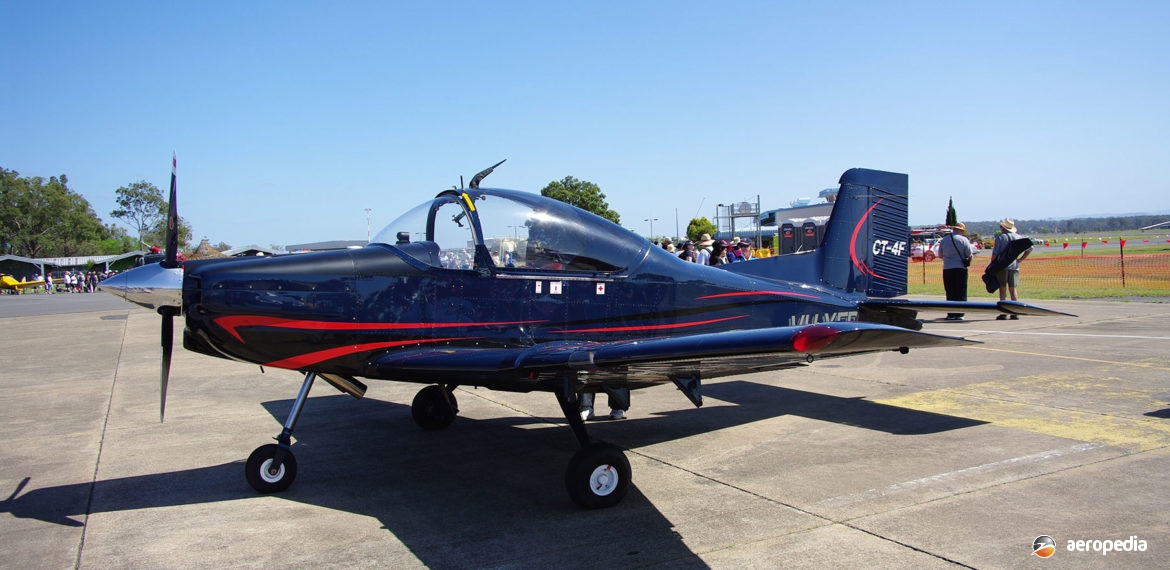Photograph:
PAC Raytheon CT-4F Akala VH-XFR² (c/n 065) at RAAF Amberley, QLD in October 2008 (David C Eyre)
Country of origin:
New Zealand / Australia
Description:
Two-seat ab initio military trainer
Power Plant:
One 224 kw (300 hp) Avco Lycoming AEIO-540-L1B5 six-cylinder horizontally-opposed air-cooled engine
Specifications:
- Wingspan: 7.92 m (25 ft 11 in)
- Length: 7.16 m (23 ft 4 in)
- Height: 2.59 m (8 ft 5 in)
- Wing area: 11.98 m² (128.95 sq ft)
- Max speed at sea level: 302 km/h (187 mph)
- Cruising speed at 75% power at 2,491 m (8,500 ft): 282 km/h (175 mph)
- Economical cruising speed: 219 km/h (136 mph)
- Stalling speed full flap: 81 km/h (51 mph)
- Take-off run at sea level: 187 m (613 ft)
- Landing run: 169 m (554 ft)
- Rate of climb at sea level: 558 m/min (1,830 ft/min)
- Service ceiling: 5,547 m (18,200 ft)
- Cruising range at 75% power: 963 km (599 miles)
- Fuel capacity: 204 litres (45 Imp gals)
- Empty weight: 862 kg (1,900 lb)
- Loaded weight: 1,179 kg (3,599 lb)
Max baggage capacity: 77 kg (170 lb)
History:
The CT-4F was a variant of the CT-4E series produced by Pacific Aerospace and Raytheon Australia, a prototype VH-XFR² (c/n 065 – ex ZK-PAC, ZK-EUN, 19-065, ZK-EUN, 65 [Rhodesian Air Force]) being built and shown at the Australian International Air Show at Avalon, VIC in 2007, this model being aimed at meeting a requirement of the Australian Department of Defence for a new trainer (AIR 5428 Programme) to replace the Pilatus PC-9 at RAAF Pearce, WA from about 2010. This model shared a common mission system with the Beechcraft T-6 and was the result of an analysis of current and future training systems that filled a critical gap between the training environment and operational requirements. It was described as representing “an entirely new approach to basic flight training for military aviators. The integration of a combat mission system enables students to develop their battle management skills from day one and ‘train like they fight’.”
The Akala (aboriginal word for parrot) prototype / demonstrator was unveiled at the Australian International Airshow at Avalon, VIC in March 2007 and featured a larger more powerful engine and a glass cockpit, the latter being basically the three MFD screens fitted to the Hawker Beechcraft T-6B Texan II turboprop trainer in service with the USAF. This airframe was previously the CT-4E prototype and had been heavily modified, having had under-wing hard points for stores or ordnance. Air conditioning was installed, and gross weight increased to 1,179 kg (2,599 lb) with no reduction in its +6/-3G strength.
To be at Avalon this aircraft was flown across the Tasman Sea with a ferry tank, life raft, immersion suit, etc with a take-off weight of 1,300 kg (2,866 lb). If placed in production the CT-4F would have had a second communications radio, radio altimeter, Tacan with DME, and a traffic advisory system. A helmet mounted HUD was an option and it would have been certified with the same equipment as the T-6B except the weapons release capability.
To compensate for the larger heavier engine, PAC moved the wing forward and placed the electronic boxes behind the pilots. Power was provided by a Lycoming AEIO-540-L1B5 engine which produced 224 kw (300 hp) at 2,700 rpm and drove a three-blade all-metal constant speed Hartzell propeller. In the event the aircraft was not placed in production, the contract for the new trainer for the RAAF being placed in 2016 with the Swiss Pilatus company for the PC-21. On 15 July 2010 VH-XFR² (c/n 065) was registered to Greenhall Holdings Pty Ltd of Grovedale, VIC.

